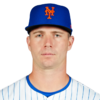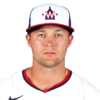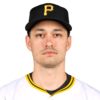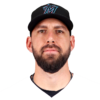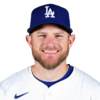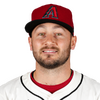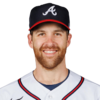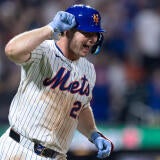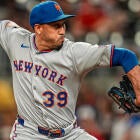2019 Fantasy Baseball Draft Prep: Sleepers 2.0 adds Pete Alonso, Ryan McMahon to the mix
How close are Pete Alonso and Nick Senzel to contributing in the majors? Close enough that you should target them as sleepers, says Scott White.
Want more sleepers for your Fantasy draft? Head to SportsLine.com and check out the all-new ACES metric to find overlooked starting pitchers. You'll find some names from this list ranked surprisingly high.
As a general rule, sleepers are players with a chance to outperform their average draft position. Pretty straightforward, right?
But I want to make the path just a little narrower here in Version 2.0, focusing more on players who aren't already established. Because while I do think Chris Archer and Yu Darvish could certainly outperform their draft position, they're also well known in baseball circles. I'll save them for the underrated list when I do my next ADP review.
I want my sleepers to be less familiar, which isn't to say you haven't heard of them. I have a separate deep sleepers column for that class of player. No, these players you may know, but you may not know what they're capable of.
Little names, big impact.
The Last-Minute Additions
Ryan McMahon took steps to shorten his swing this offseason after being overmatched by major-league fastballs last year. The result has been a bunch of extra-base hits this spring for a player who suddenly looks more like the one who hit .355 between two minor-league stops in 2017 than ... whatever we saw last year.
The transformation has been so stunning that it has made McMahon the obvious choice to start at second base for the Rockies even though Garret Hampson, the presumptive favorite coming in, has had a nice spring himself. Hampson is still a sleeper for steals and may get close to a starter's workload as a super utility player, but McMahon looks like another homegrown hitting stud who will soon have the good fortune of calling Coors Field home. Even if he ends up sitting for Hampson against tougher lefties, the impact potential is high.
While McMahon has probably been the biggest hitting success of the spring, Chris Paddack takes home the pitching honors. The 23-year-old wasn't even thought to be a serious contender for the starting rotation considering he threw only 90 innings last year, his first back from Tommy John surgery. But his outrageous strikeout-to-walk ratio has carried over against big league hitters, with his ridiculous fastball/changeup combo racking up swings-and-misses aplenty. It's to the point where the talk has shifted from him not just making the rotation but also starting on opening day.
There will be limits, of course, given his injury history and limited buildup. But the impact could be considerable for however long he's around.
The Newcomers
New general manager Brodie Van Wagenen said early on that he wanted Pete Alonso to be the Mets' opening day first baseman, and the rookie has done his part to win the job this spring. In fact, it sounds like he has secured the job heading into the final draft weekend.
It never made sense for Alonso to last beyond the top 200 picks. Even if he was sent down at the start of the year, the timetable wouldn't have been so different from the one that gets Vladimir Guerrero drafted in Round 6. And while Alonso isn't a prospect on the same level, his bat should make an immediate impact. We're talking true 80 power grades from some scouts, with exit velocities that measure up to some of the game's biggest sluggers, and some pretty good plate discipline to boot. I'm hopeful of something like Rhys Hoskins-level production from Alonso in his rookie season.
Nick Senzel, himself a top prospect, hasn't gotten the same loud endorsement that Alonso has from management, but if you piece together everything manager David Bell is saying about his outfield, it's pretty clear that the 23-year-old is the Reds' Plan A in center field, even if it looks like it'll be later in April.
On Scott Schebler's ability to play center and left field:
"Yeah, it is valuable," Bell told MLB.com. "We're confident he can play all three. We do want to see him in center, but he is going to play right and left."
On Matt Kemp's role with the team:
"It's a great question, because he's been such a good player for so long," Bell told MLB.com. "I do believe, and I've said it a lot, that things do work themselves out. How exactly that's going to happen, I don't know."
And on Senzel, a natural third baseman, making the conversion to center field:
"I feel like he can do it. There's no question, really, that he can do it," Bell said. "That's what has become clear — he has the ability to do it."
Oh yeah, he's in. You heard it straight from the horse's mouth: Schebler will be playing right and left, not center, and Yasiel Puig won't be moving to center to accommodate Kemp, who instead will be waiting for things to "work themselves out." So that just leaves Senzel for center field, and it's a great thing. The second overall pick in the 2016 draft has the sort of bat that should transition easily to the majors, boasting a plus hit tool with projectable power. And because he enters the season with second base eligibility, seeing as that's where the Reds tried to work him in last year, he's an easy fit at a weak position.
Normally sleepers are hyped for their upside, but Marco Gonzales is an unusual case. You don't often find pitchers with his lack of downside available in Round 20-plus of a 12-team league. And maybe that's a strange way to put it for a player with a considerable injury history, but speaking just to the skills, he has a safe profile. He keeps the ball on the ground, delivering the ninth-lowest fly-ball rate of any qualifying pitcher last year, and he keeps the ball in the zone, delivering the fifth-lowest walk rate. It's basically the Miles Mikolas profile, though Gonzales was the better strikeout pitcher of the two last year.
And I'm not suggesting he has no upside. In fact, if he hadn't tried pitching through neck pain last August, finally succumbing to the DL, he probably wouldn't be going this late. He entered the month with a 3.37 ERA and then came back from the DL to deliver a 1.71 ERA in four starts.
Run prevention: There's really no substitute for it, especially late, and Gonzales seems well equipped for it. He's a fine choice to round out a staff in any format.
It feels like most Fantasy prognosticators spent the offseason assuming the big-dollar Red Sox would bring in a big-dollar closer and are now struggling to adjust to the idea that, um, apparently not. They've been slow to come around to the in-house candidates, and drafters have followed suit, selecting front-runner Matt Barnes 283rd on average, about 50 picks behind such legendary stoppers as Mychal Givens and Shane Greene.
Folks, he's better than that. His 14.0 K/9 ranked sixth among relievers with at least 50 innings last year, ahead of Craig Kimbrel for one, and while the ERA was on the high side, his FIP, xFIP and SIERA all suggest it should have been closer to 2.80. He gives up weak contact, mostly on the ground, which reduces the odds of a walk-off home run — and that's if anyone makes contact off him in the first place. The walks are kind of high, but not abnormally so for a reliever with his kind of stuff, and if he does secure the role as expected, it'll be his — no committee.
By putting him out there as the favorite this far ahead of opening day, the Red Sox did us all a favor. Among late-round saves sources, he feels uncommonly safe, with the potential to be spectacular.
As you'll discover when you scroll down to the The Holdovers, I've already made the case for why Collin McHugh's return to the Astros rotation is a big deal for Fantasy owners, Now I'll do the same for Brad Peacock, who has emerged as the favorite for the fifth starter job while late-blooming prospect Josh James contends with a quad injury.
Actually, I'll just direct your attention to it. Those numbers above? They're not what Peacock did out of the bullpen last year. They're what he did in 21 starts for the Astros two years ago. That's right: 10.9 strikeouts per nine innings as a starter. It's when we first came to learn just how dominant is his then-fledgling slider (the one he has since taught to McHugh.). And while he wasn't a model of efficiency, he was efficient enough to win 10 of those 21 starts, throwing six-plus innings nine times. That's pretty typical for non-aces these days.
One of my saddest days last offseason was when I came to realize that the acquisition of Gerrit Cole meant no more starts for Peacock, but the Astros can right that wrong now. And while it's no guarantee he remains in the rotation once James is ready to go, I think they'll have a hard time taking him out.
Back in October, Jeff McNeil would have been on most everybody's sleeper list, but when the Mets acquired Robinson Cano and Jed Lowrie this offseason, it seemed like they were giving the surprise 26-year-old the heave-ho.
Not so. They said at the time they would try him in left field, and now there's an even easier path to playing time with Lowrie expected to begin the year on DL. So we know McNeil will start out at third base before eventually switching to left field, but the enthusiasm is still lacking.
What the above numbers don't show is that he struck out just 24 times for a rate on par with Michael Brantley, so we're talking elite bat control and surefire batting average help. What they also don't show is what he did prior to his promotion last July, homering 19 times in 339 at-bats between Double- and Triple-A (most of them coming at Double-A, by the way, so he wasn't just a product of the hitter-friendly PCL). There's power there that he didn't show at the big-league level, and nothing in his batted-ball profile that's actively working against it (like a low fly-ball rate, for instance).
Add that he was 7 for 8 on stolen bases in what amounts to one-third of a season, and it's possible he's a five-category contributor on the level of like an Andrew Benintendi. It's asking for a lot to go right, of course, but even if he just picks up where he left off -- so no power increase -- there's plenty to like. He averaged more Head-to-Head points per game last year than Travis Shaw and Gleyber Torres.
The Holdovers
OK, so I did leave one big name in The Holdovers, but the scenario is just too perfect for Daniel Murphy.
If there's anything that'll rescue a hitter from the downward spiral of age, it's a move to Coors Field — and especially this hitter, whose high-contact, line-drive, all-fields tendencies are so pronounced that a .300 batting average already feels something like a floor for him. He's taking those skills to a park where, because of a variety of environmental factors, it's not uncommon to see much of the lineup with a better-than-.330 BABIP — a range where he already resides.
The soon-to-be 34-year-old's value would appear to be at a low point after a season in which he struggled to come back from knee surgery and saw his power numbers decline, and if he signed just about anywhere else, he would be an equally convincing bust candidate. But it turns out he went to the one and only place where fantasizing about him hitting .360 wouldn't be an intellectual betrayal.
You might wonder how anyone could sleep on a player who hit 35 home runs home runs last year. Yeah, it's because the Dodgers themselves did after acquiring Manny Machado and Brian Dozier last July, forcing what had been their best hitter to that point to the bench against left-handers (an unfair banishment considering he had a .971 OPS against lefties at the time, finishing at .891), which basically resulted in him starting just 29 of the team's final 55 games. Just imagine his numbers if he hadn't lost that time.
But because he did and because of the lingering perception he's a part-time player (despite the losses of Machado, Dozier, Yasiel Puig and Matt Kemp), he's not being rated like an elite slugger who had the fifth-best walk rate and fifth-best OPS of any hitter in 2018. You want upside? It's here. In fact, I can't say for sure he won't be the most productive first baseman in 2019.
When the Blue Jays dealt Russell Martin to the Dodgers in January, it confirmed what seemed like the obvious path for a team in rebuild mode: Danny Jansen is the man behind the plate now. His anointment is well deserved given the strides he made offensively during his past two minor-league seasons, and it comes at a time when Fantasy owners are desperate for anything resembling production behind the plate.
What he brings is a low-risk profile, a welcome departure from the Mike Zunino and Austin Hedges fakeouts of recent years. Jansen comes with the potential for a 1-to-1 strikeout to walk ratio and at least doubles pop — basically what Martin was during his best years in Los Angeles, or perhaps even closer to an in-his-prime Jonathan Lucroy. It's a profile that doesn't require big home run power to be impactful, especially at a position where so many of the hitters are their own worst enemies, which means Jansen should threaten for top-five numbers with full-time at-bats.
Hampson's minor-league track record paints him as the ideal leadoff man, which not only means he reaches base at a high rate but also that he's fast, offering the kind of stolen base potential (123 in 305 minor-league games) that would make him an answered prayer to Rotisserie owners if they could trust him to play. But there's no guarantee he gets the second base job, not with fellow up-and-comer Ryan McMahon dominating this spring. It's that uncertainty combined with the fact Hampson feels out of place in today's homer-happy environment that will keep him affordable on Draft Day.
But given that it's an ideal leadoff profile and given that Coors Field's BABIP-inflating ways make it almost impossible for a contact-oriented hitter like him to fail, there's a chance he plays enough to make an impact even in a super utility role, being capable of manning shortstop and center field as well.
Collin McHugh's banishment to the bullpen will last only a year thanks to the departures of Dallas Keuchel and Charlie Morton, and will prove to be time well spent if it renews his focus on what the Astros' prophetic team of number crunchers have been preaching to him since his arrival in 2014: The best application of his innate ability to spin the ball is to feature a four-seam fastball and a curveball.
But he also brings new tricks, having picked up a slider from teammate Brad Peacock (who saw his career transformed by that same slider) to help make McHugh's curveball even more effective in his bullpen role. It's a potentially devastating three-pitch mix that could yield career-best numbers for the starter version of McHugh. That's saying something considering he had a 2.73 ERA, 1.02 WHIP and 9.1 strikeouts per nine innings over 25 starts in 2014.
The Cardinals never seemed to think much of Luke Voit, and the Yankees didn't give up much to get him, which would seem to support the idea that what he did down the stretch, homering 14 times in 39 games with his new team, was a Shane Spencer-level flash in the pan. But what does it say that the Yankees, with their seemingly unlimited resources and constant presumption of contention, are basically handing him the opening day job, offering only the decrepit Greg Bird as a challenger? They know what we'll all soon discover: There may not be a right-handed slugger better suited for Yankee Stadium.
Voit is a strong man with massive forearms, but his power doesn't translate everywhere because he's so line-drive oriented (positioning himself for a high BABIP, meaning he's not just a pure slugger) and so opposite-field focused (pulling just five of his 15 home runs last year and 16.2 percent of his fly balls overall). Given how short that right-field porch is in his home venue, a 30-homer season seems like a modest estimate.
Joe Musgrove is known for living in the strike zone, issuing just 1.8 walks per nine innings last year, which makes for an efficient pitcher but not always an effective one. He took steps toward remedying that issue last August, though, trading out his sinker and cutter for his best two swing-and-miss pitches, the changeup and slider, over his final seven starts, and the effect was startling. He struck out 44 over 41 1/3 while issuing just four walks. The problem was he had a 5.23 ERA, ballooning his season mark from 3.41 to 4.06.
There's no doubt the change worked, though: His swinging-strike rate during that stretch compared to Jacob deGrom's and Blake Snell's full-season marks. And while it did make him more vulnerable to fly balls, some of his worst starts during that stretch were the three in which he didn't give up a home run, suggesting his struggles were more a product of bad luck. If he sticks to the approach and isn't discouraged by the outcome, he could tip the scales of that Gerrit Cole trade a little back in the Pirates' favor.
Reyes split his time almost evenly between the majors and minors last year and hit a combined .299 with 32 homers and a .931 OPS in 144 games, which makes a pretty convincing case on its own. But factor in that he looked completely overmatched in his initial two-month stint in the majors before returning Aug. 5 to hit .318 with 10 home runs and a .933 OPS in his final 49 games, and you get a better idea of his potential.
Reyes struck out 40.4 percent of the time in that first stint, which no hitter could survive, but only 21.8 percent of the time in his second stint, which is comparable to Christian Yelich and much more in line with his minor-league stats. Add the fact that he pulled only a third of his batted balls and had an average exit velocity that ranked between Giancarlo Stanton and Mike Trout, and the 23-year-old is more than the hulking slugger his 6-foot-5 frame would suggest. Sure, he technically has to win a job first, but if his bat has a say, he will.
While it's true top prospect Kyle Tucker waits in the wings and on-base specialist Tony Kemp also figures to have a say, Tyler White stands as the heir apparent to Evan Gattis at DH, namely because ... well, he kind of took over before last year even ended. It was mostly a case of him wresting the job away, maintaining an OPS over 1.000 for about a two-month stretch from mid-July through mid-September, which seemed totally in character seeing as he hit .333 with 14 homers and a 1.013 OPS in 70 games for Triple-A Fresno.
Of course, the 28-year-old has gotten chances in the past and blown them, which is why the way he finished last season, batting .170 (8 for 47) in his final 15 games, has rendered him an afterthought in Fantasy still. When performing at his best, though, there were no obvious red flags in his batted ball profile, and seeing as he hit .323 with 26 homers and 1.011 OPS over the first 5 1/2 months last season, majors and minors combined, it seems like more could go right than wrong for the cost of a late-round pick.
So which Fantasy Baseball sleepers should you snatch in your draft? And which undervalued pitchers can help you win a championship? Visit SportsLine now to get Fantasy Baseball rankings for every single position, all from the model that called Scooter Gennett's huge breakout last season, and find out.





